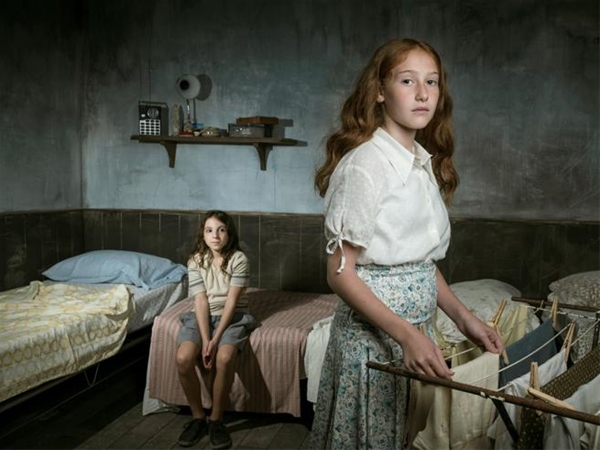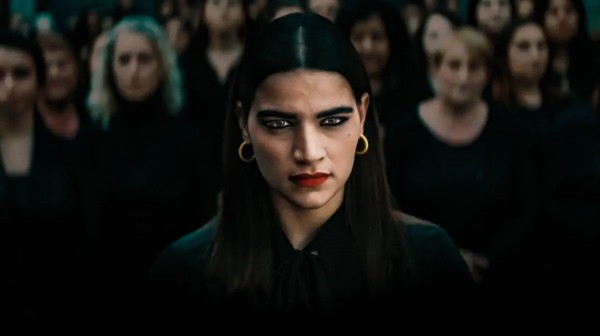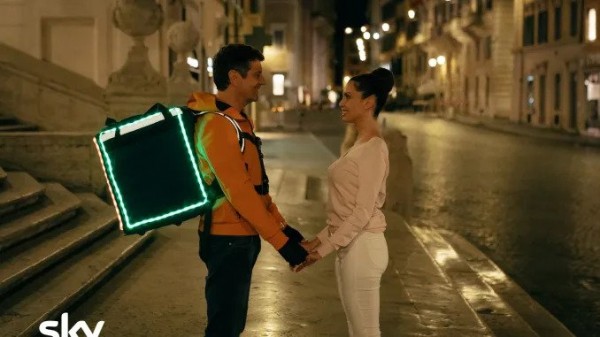-
Open Roads: New Italian Cinema at Lincoln Center 2022
Last edited by Chris Knipp; 06-09-2022 at 12:53 AM.
-
A GIRL RETURNED/L'ARMINUTA (Giuseppe Bonito 2021)
GIUSEPPE BONITO: A GIRL RETURNED/L'ARMINUTA (2021)

CARLOTTA DE LEONARDIS AND SOFIA FIORE IN L'ARMINUTA
A girl adopted by cousins is returned to her poor country parents at the age of thirteen and has to adapt
Giuseppe Bonito's third outing as a director is a film adaptation of the 2017 Premio Campiello-winning, bestselling novel L’Arminuta (the original film title) by Donatella Di Pietrantonio, which was translated into English by Ann Goldstein, the translator of Elena Ferrante. The story works well on screen because of the simple narrative structure and the clarity with which it is filmed. It transpires in 1975, mainly ih the rural part of Italy's Abruzzo region east of Rome; the title "L'Arminuta" is Abruzzese dialect for "the returned one," and it refers to the young teen protagonist.
An Italian review site, MyMovies, explains that after the Sixties Italian economic boom, town and city life had speeded up, but in the country a "heavy backwardness" persisted. Hence the custom, which the author says still persists, of farming out children from country to town. This time "L'Arminuta" (Sofia Fiore), a poised, tall girl with long red hair, at the age of 13 is brutally "returned" to a harsh life with her biological family that she has never known. The film unreels scenes of this shocking new life.
Well educated and raised as a cosseted only child, "L'Arminuta" learns her "mother" was her aunt. Now she must sleep in one room with two brothers and two sisters, all uneducated, and expected to do farm chores or day labor. At the table, nobody speaks. Finally her birth mother (the perpetually sad Vanessa Scalera, whose downturned mouth is like Jeanne Moreau's) explains some things. why the girl has been "returned," like a package in the mail, doesn't come out till later, and can never really be justified. But there is soon fun in an aerial ride at a country fair where the 18-year-old older brother, Vicenzo (Andrea Fuorto) wants to run off again with the gypsies who operate it, for which his father smacks him and whips him with his belt.
Vincenzo develops an inappropriate interest in "Larminuta." Fuorto makes the sweetest of incestuous predators - whom tragedy prevents from going too far. Younger sister Adriana (Carlotta De Leonardis) bonds with "L'Arminuta" and looks up to her. They sleep in the same bed head-to-toe. At 10, Adriana is still a bed-wetter, but for "L'Arminuta" this relationship is sustaining. So is the fact that at the local school, "L'Arminuta" winds up being the best student, winning a financial prize for writing a science fiction story - about 'an alien,' like her, also a compensation.
Our expectation of a grim Dickensian tale is deceived from the start with the sequences of fairground fun and later a bright-colored seaside visit with Vincenzo and Adriana, to near where the girl grew up. She finances it with one of the envelopes of money her adoptive mother Adalgisa (Elena Lietti) sends her - but never a note. True, "L'Arminuta's" birth parents' have an impoverished life; but it's not that impoverished. They have a tiny car, for instance. The way in which a visit with Adriana to her adoptive mother and her new husband, with their new baby, puts paid to that whole episode is elegantly ironic and neat - as befits this film's short, economical novel source. And this is a neat, economical movie. It was the only Italian film included in its year's Rome Film Festival.
It's awkward to have to keep repeating "L'Arminuta," but the author, Donatella Di Pietrantonio, wants to hammer home her point that this "package" girl, shipped back and forth, has been robbed of a real identity. In "Goodreads," where everyone is admiring of the book, someone thinks the protagonist deserved a name. Another issue, apropos of the incestuously predatory older brother, is, who is this written for? You can't put that in a YA novel, someone says. It's in limbo, like its protagonist.
The bright, pictorial cinematography is by Alfredo Betrò. Monica Zapelli collaborated with the author on the screenplay, which captures the economy and richness the "Goodreads" contributors speak of. Their success is marked by the fact that this movie feels short and swift despite being close to two hours long.
A Girl Returned/L'Arminuta, 110 mins., debuted at Rome Oct. 15, 2021, and won the David di Donatello Award for Best Adapted Screenplay. It was screened for this review as part of Lincoln Center's Open Roads: New Italian Cinema festival, June 2-15, 2022, where it will be shown Jun. 11 at 2:45 and Jun. 14 at 6:30.
Last edited by Chris Knipp; 06-02-2022 at 06:25 PM.
-
THE CODE OF SILENCE/UNA FEMMINA (Francesco Costabile 2022)
FRANCESCO COSTABILE: THE CODE OF SILENCE/UNA FEMMINA (2022)

LINA SICILIANO IN UNA FEMMINA
Dark explorations of a fearless girl
Francesco Costabile's first feature in a way couldn't be more Italian, if Italy to you is the south and the mafia. The focus is Calabria, and the entire film is in thick Calabrian dialect. In the foreground is a young woman, Rosa (the deep, dark, heavy-featured Lina Siciliano; Mauro Donzelli of the Italian film site ComingSoon speaks of her "antique face"), who wants to explore or expose the past, pull away the dark curtains of her mother's mysterious death when she was a young girl. Rosa is supposed to be still only a teenager now, but her dark Mediterranean features carry a weight that makes her seem older, even ancient. Maybe she already knows everything she wants to find out. Hovering over all, the family and formerly warring clans that have held a truce till now, is La ‘Ndrangheta, the Mafia's local version and the code of omertà, not telling, shared silence.
The beauty of the dark images of dp Giuseppe Maio makes up - for a long time, anyway - for the paucity of information and the tendentiousness of the scenes, which at first are little whispered chiaroscuro sketches, expand to big, dark, ceremonial encounters. The sepia hazes and early scenes half out of focus are at once threatening and sensuous. For a while the campy chiaroscuro made me think of Visconti's 1965 Sandra/Vaghe stelle dell'Orsa, though that film tells a very different and much clearer story. Midway the screen opens up to a building in flames, a barn provocatively torched, and it's magnificent after all the darkness and the claustrophobic black-clad figures. Costabile fetishizes repression by how beautiful he makes the darkness and the silences. I thought of some old-timey, grandiose comic book, "Prince Valiant" perhaps, as well as Phil Tippett's recently released Mad God. When it reaches a fever pitch of gruesomeness, it could evoke the American photographer of death, Joel-Peter Witkin. It's soporific, but it's also hypnotic, mysterious and terrifying, even though Rosa seems afraid of nothing.
Rosa's question-asking is an act of rebellion, which links her with her vanished mother, who evidently was guilty of some infraction that required the ultimate wiping-clean. The scenes of the film depict repression being pushed back against, with the threat of something about to explode. Things do explode in the second half, the long-repressed feuds breaking out again in an orgy of revenge touched off by Rosa's revenge for the death of her mother. Rosa disrupts the established power structures: one is the longstanding truce between her uncle Salvatore (Fabrizio Ferracane) and his arch-rival Ciccio (Vincenzo Di Rosa), which the vengeful Rosa secretly sabotages. By then she has become such a heavy dude, the enemy capo wants her. And in the final shot, as Rosa enters a tunnel shot leading to a cosseted car ride, he may have gotten her; or is she turning state's witness? At least she has already lost her rough gamine look and become sleek and soignée. But nothing very clear has happened. Costabile has proved good at atmosphere and great at moody visuals but a washout at telling a coherent story.
This was all "freely inspired" by the book by Espresso magazine investigative journalist Lirio Abbate, Fimmine ribelli. Come le donne salveranno il paese dalla n'drangheta, "Rebellious Females. How Women Will Save the Country from the 'Ndrangheta." (The convoluted plot thus "inspired" is by screenwriting duo Adriano Chiarelli and Serena Brugnolo, reportedly with some involvement by Abbate.) But does Rosa 'save' the country from the Calabrian syndicate, or join it? Costabile's film apparently chooses to use the book and his formidable female protagonist in mainly atmospheric, ambiguous, ambivalent ways. He's an artist, half in love with easeful death, and not a muck-raker. Muck is the medium he paints with.
The Code of Silence/Una femmina, 120 mins., debuted at the Berlinale Panorama section in Feb. 2022 and opened theatrically in Italy then also. It was screened for this review as part of the 14-film Jun. 9-15, 2022 FLC-Cinecittà Open Roads: New Italian Cinema series at the Walter Reade Theater.
Saturday, June 11 at 5:30pm (Q&A with Francesco Costabile)
Last edited by Chris Knipp; 06-08-2022 at 11:23 PM.
-
UNFINISHED/IL PALAZZO (Federica Di Giacomio (2021)
FEDERICA DI GIACOMO: UNFINISHED/IL PALAZZO

STILL FROM IL PALAZZO
Celebration of a Roman movie director who died without ever completing a film
The late Mauro Fagioli is the absent subject of this film. It's for him the friends gather at his rooftop apartment in Rome in the opening sequence. They are members of an urban intellectual middle class, and it's an ample roof terrace - with a bathtub, in view of Saint Peter's, twenty years after their youth, to commemorate Mario, who recently died too young of... something. Early on we glimpse him, nude, boyish, a little chubby, briefly cavorting for a camera in an old film strip. In the present, they chat, they sip wine, and following Mauro's wishes they listen together to an excerpt from the Brahms' Requiem - and then take other routes toward reunion and remembrance.
It doesn't hurt that this is an artistic, intelligent branch of the Roman urban bourgeoisie featured in this documentary film. (One hates to call it that; it's meant to feel like the feature its subject was always ostensibly working on.) They are better looking - some of them, anyway - than their equivalents in other locations might be, and they still have articulate things to say. It is interesting, and the bemusement and dissatisfaction are glamorous. Mauro was never a success. But this memorial shows that, as Yeats wrote in a different context in his great poem To a Friend Whose Work Has Come to Nothing, a life is not wasted just because it's not complete in the world's eyes. (There is one sequence where Mauro's ample tombstone is lovingly tended, his spirit visited and appeased with cellphone music.)
In 2018 Mauro Fagioli died at the age of 47. For a long time he had been a recluse on the top floor of an apartment building ("palazzo" in Italian) in affluent Rome where he carried out his only activity, finishing the film of his dreams with material collected over a twenty-year period, hours and hours of peripatetic filming in which all his friends lent a helping hand. It's these same friends who're filmed gathering on the building's terrace to celebrate Fagioli's wake, remembering his unfinished task. Some of them have not seen each other for a dozen years, and they take this opportunity to revisit their common past and reconnect (or not). This film is a record of that reunion, of those people, and of Mauro and the many pieces of film he left dangling when he passed away.
The documentary by Federica Di Giacomo, already the author among other films of the 2016 Venice Orizzonti-prize exorcism documentary Liberami ("Set Me Free"), stands at an imaginary crossroads, suggests Paolo Casella in his review for MyMovies, (which I've borrowed from freely here), between Matteo Garrone's 2000 artist reunion film Estate Romana, James Franco's 2017 bad movie flick The Disaster Artist and Lawrence Kasdan's 1983 generational reunion classic The Big Chill, but recounted from within a specifically Roman world: that of aspiring filmmakers and the court that is created around them, as well as the sense of non-accomplishment some of those presently assembled also feel.
Gradually the cast of players is defined, though they appear casually, as in a film. There is a journalist who stubbornly demands the truth and calls Faggioli's work "meaningless delusions." There is the writer devoured by the bitter awareness of not having realized his own aspirations: but he is the co-author of this documentary, so he has finished something, even if he says he differs from Mauro only in still being alive. There is the disenchanted ironist who asks himself questions the audience will ask. There is the "crucifer" who has become the guardian of Fagioli's memory. Some of the men here live by expedients; one of them is a drunk. The women get down to work, but regret no longer being the beauties Fabioli's camera recorded as we see them in Mauro's much earlier film strips.
If these were fictional characters perhaps we would not understand their irresolution so well. But Di Giacomo, who was one of this original cohort herself, builds up the narrative arc of each of them in the editing, leaving room for surprises and revelations, only at the end partially reconstructing the puzzle of Fagioli's existence and his entourage. The director and co-writer manage to maintain a suspension of judgement, often colored by irony but never by derision, towards these characters, a number of whom seem "dedicated to failure." (There feels like something particularly Italian, perhaps even Roman about this. The cultural patrimony of Italy is overwhelming, and Mauro's terrace provides a view of the Vatican.)
There are meandering, almost Felliniesque segments, like the drunken amble on nighttime Roman streets, and the pair of women in elegant sun suits who go to the beach, only to have one of them announce she is fed up and is taking the Metro back. Now with a shock we see Mauro during his latter days. He had a vertebral problem and took heavy doses of cortisone and had become enormously, unnaturally fat. (Come to think of it, at this stage he could have been a Fellini extra himself.) We still don't know the cause of death, though.
In between some segments of film work only as disconnected vignettes. Perhaps they're like Mauro's except that they're recorded with live sound while he, we see, intended to dub his film in the traditional Italian style and so gives loud instructions during shoots, like the silent film directors, thereby getting to play the classic director role vividly, if in the end futilely. He shot himself directing these fragments, his performances.
With its meandering runtime Il Palazzo winds up not living up to its initial elegance and suggestiveness of the gathering of glamorous friends. Various segments involving the group after - or before - the terrace wake are too peripheral to the subject. Information about a man who owns apartments (in Mauro's building?) who sells them to finance art projects for the group is not quite clear. This gathering of scenes will make sense to the participants, but doesn't completely make sense to us.
Suppose Mauro hadn't had these physical problems and died at 47, would he have produced something? From the evidence provided, that's unlikely. He admits in one clip to having no interest in story or screenplay-writing: perhaps no interest in ever making a completed film. Maybe he was just saved by early death from the desultory old age his contemporaries will grow into. This film is the flavorful record of a small Roman community whose surroundings may be as oppressive as they are beautiful and gracious.
Unfinished/Il Palazzo, 100 mins., debuted Sept. 2021 at Venice Giornate degli Autori. Screened for this review as part of the FLC-Cinecittà series Open Roads: New Italian Cinema, shown June 9-15, 2022 at the Walter Reade Theater.
Sunday, June 12 at 2:15pm (Q&A with Federica Di Giacomo).
Last edited by Chris Knipp; 06-02-2022 at 09:54 AM.
-
SING RIDE/CALCINCULO (Chiara Bellosi 2022)
CHIARA BELLOSI: SWING RIDE/CALCINCULO (2022)

GAIA DI PIETRO, ANDREA CARPENZANO IN SWING RIDE
The zoftig girl is not happy so she runs away with a fair
The feeble outsider-bonding picture Swing Ride/Calcinclo, the director Chiara Bellosi's second feature, fails either to achieve verisimilitude or to entertain; both characters and action are underdeveloped. The main trouble is the fifteen-year-old protagonist, an overweight girl called Benedetta (Gaia Di PIetro). The film doesn't define her situation clearly or work up enough sympathy for her. Benedetta's situation certainly feels sad. Like so many teenagers, she doesn't fit in. On the other hand Di Pietro seems perfectly comfortable in her body. Her mother takes her to a doctor at the beginning. The camera closeups on her body seem to want to make her seem monstrous. Later, when she appears head to toe, she seems both attractive and at ease in her body; still later she turns out to be a great dancer and a fast runner. Smaller kids yell mocking epithets at her from a distance once. But what her life is like at school there are no scenes to tell us. Clearly, she hides away in her room before she meets the outsider she bonds with.
Early on Benedetta's mother has her being weighed and given a strict diet. When the rest of the family noshes down at dinner, Benedetta gets a small salad she only picks at. At night she raids the fridge and consumes a whole package of raw chicken (happily we are spared seeing this play out). Yet earlier it's stated (1) that the problem's not hormones and (2) that she doesn't eat that much. This ill-definied situation is simply dropped, as the later plot line comes into play, the outsider-bonding.
But first comes the frustrating, inadequate family portrait. Mom, Anna (Barbara Chichiarelli) is resentful because she claims getting pregnant with Benedetta robbed her of the opportunity to become a professional dancer. Anna is a scrawny,, disagreeable person. Dad (Giandomenico Cupaiuolo) is simply childish and self-absorbed. He has long supported the family working at a glass business, but his whole interest is in buying old sports cars and restoring them and that's all he talks about at the dinner table.
But the inadequate or cruel parenting, like Benedetta's ill-defined weight and eating problems, falls away after the early scenes when we don't see any more of the family after the traveling fair arrives nearby and Benedetta meets the trans person, Amanda (Andrea Carpenzano), and latches onto him despite his apparent indifference. Symbolically, he bonds by awarding her the largest and prettiest of the fanciful toy butterflies he collects, gifts from somebody we don't meet. Later, he burns the remaining butterflies, no doubt also symbolic, ostensibly of Amanda's unwillingness to get attached to anything.
Especially since Benedetta is lumpish and ill-defined, for whether or not this film works a lot rests on the depiction of Amanda. It's a focused performance, and has been compared to Jared Leto in Dallas Buyers Club, but despite Carpenzano's assurance, he never seems anything but a skinny actor pretending to be a man posing as a woman. (What Amanda does for the fair isn't clear.) The film doesn't allow us to become fully absorbed into Amanda's fantasy, and the flimsy frocks, makeup, and complicated hair remain flimsy, inadequate facades between the fantasy of womanhood and the skinny actor.
The scene when Amanda takes Benedetta on a swing ride at the fair, grabbing her and letting her go over and over, is meant to be uplifting and transformational, but this crucial moment, like so many of the other scenes, fails to soar.
For a while Benedetta runs away with Amanda when the fair picks up to go elsewhere. A scene where Amanda pimps Benedetta out to a man without her knowledge has possibilities because it's energetic and surprising. Otherwise this rather improbable final sequence doesn't go anywhere except to further depict Amanda's ambivalence and trouble showing affection, even after he-she has allowed Benedetta to ride along and even share his/her bed, and the film ends limply, unresolved, as unsatisfactorily as it began.
A German online review finds the treatment of obesity clichéd and offensive and after several moments that distort the depiction of the lead character, after the fridge raiding scene rejected the film completely. This shows how inadequate this film is in depicting the issues it purports to raise. The actors are doing their best. The screenplay by Luca De Bei and Maria Teresa Venditti, despite it's having won won Italy’s prestigious Solinas prize in 2018, doesn't provide them with enough to work with, and Chiara Bellosi's direction is weak. There isn't much material here. Happily, at least, the run-time is short. If the peppy, cheerful music by Giuseppe Tranquillino works for you, maybe you will like this picture.
Swing Ride/Calcinculo, 88 muns. debuted in the Panorama section of the Feb. 2022 Berlinale. It was screened for this review as part of the June 9-15, 2022 FLC-Cinecittà series Open Roads: New Italian Cinema series at the Walter Reade Theater, Lincoln Center.
Friday, June 10 at 6:00pm (Q&A with Chiara Bellosi)
Monday, June 13 at 1:00pm
________________
Last edited by Chris Knipp; 06-09-2022 at 12:31 PM.
-
ON OUR WATCH/E NOI COME STRONZI RIMANEMMO A GUARDARE (Pif 2021)
PIERFRANCESCO DILIBERTO (PIF): ON OUR WATCH/E NOI COME STRONZI RIMEMMO A GUARDARE

FABIO DI LUIGI, ILENIA PASTORELLI IN ON OUR WATCH
Pif's new satire shows we are the victims of our own algorithms
Pierfrancesco Diliberto/PIf's 2013 satire was The Mafia Only Kills in Summer/La mafia uccide solo d'estate, a semi-autobiographical tale that depicted himself as a Forest Gump-like precocious youth who meets with real political reformers in his native Sicily. This time he has bigger fish to fry, taking on worldwide tech empires and the loss of individual freedom for everyone not at the top. It's not likely this treatment of the theme will play well outside Italy, however, because it's still true that Pif has a TV comedy-writer's fragmented sensibility, and once again his movie falls into two different halves. What is true also, though, is that he really makes you think hard about mega-corporate capitol exploitation of labor in a world where there is zero privacy, zero opportunity, and trade unions are only "a moment of nostalgia." And of course all business is done in English. Automated job instructions, delivered by hologram to Italians come blithely couched in heavily American-accented Italian.
Bitter stuff, this, and for a long time the suggestion that it's maybe supposed to be funny sticks in the craw. But Pif saves things - a bit, anyway - a little past midway by having the action turn into a love story, if perhaps a doomed one. There was that aspect to Orwell's 1984 too, wasn't there? And 1984 is a comparison that comes to mind.
The twist is that this is a superficially fluffy, appealing world of fantastic skinny mushroom buildings and quiet car-free transportation - and sometimes it's just Rome. It seems like a budget production until it appears the hero really does go to Mumbai, as the story requires. Now, the villain isn't Big Brother, an oppressive dictator in a grim, gray, totalitarian world like in Orwell's dystopian tale. The new ruler is technology, specifically algorithms, with smiling, folksy billionaire tech "geniuses" taking all the profits. And we give ourselves to them willingly, for a job or a bit of fun - in the Italian title, "we sat by like assholes and watched."
The everyman is Arturo (Fabio De Luigi), who is an executive for a corporation who creates an algorithm to achieve more efficiency. When it's employed, there's just one little problem: it makes Arturo too redundant. Enter FUUBER, whose inspiration is not hard to detect, Uber with a hint of Fuhrer. The creepy young American founder John Fuuber (Eamon Farren) sells inspiration, and behind it, total exploitation of its employees, who think they are serving a higher cause but are more like slaves. Jobless and penniless, the middle-aged Arturo becomes a delivery man on a bike enslaved to merciless algorithm time requirements and piddling rewards. He takes in a roommate to hold onto his apartment, Raffaello (Pif himself), a university professor of Romance Philology (Arturo's surprised they still exist) who must moonlight as an online "hater" for hire.
All kinds of hardships befall Arturo in his lousy job, as he continues with sad-sack persistence: Pif carries this part to where the "comedy" turns into a drag. A saving human strain arrives however with the idea of hologram "ideal friends." Both Arturo and Raffaello take free trials of these, though Arturo at least can't possibly afford to pay the 199-euro-per-week regular fee. He loves Stella (Ilenia Pastorelli), though: she's all that makes life worth living. Ironically, Rafaello's Ideal Friend, chosen by algorithm of course, is a man, Jean-Pierre (Maurizio Marchetti). The screenplay never delves into the possible implication that this means Raffaello is secretly gay; he just keeps turning off this Friend - till he too, starts to be dependent.
Thus for Arturo, after his job has gone to nothing and he is in deep financial shit, this turns into a love story. Stella turns out to be a real person, projected as a hologram from FUUBER's central headquarters in the giant FUUBER tower in Mumbai. To do Pif credit, though his movie changes course by turning into a conventional search for the lost lover, it never completely loses the original point because Pif's depiction of his perverse tech empire is now being pursued to its source. The suggestion that we are letting all this happen is not lost on us.
On Our Watch/E noi come stronzi rimanemmo a guardare, 108 mins., debuted at Rome Oct. 23, 2021 and opened theatrically in Italy Oct. 25. Screened for this review as part of the FLC-Cinecittà Jun. 9-15, 2022 series Open Roads: New American Cinema at the Walter Reade Theater, Lincoln Center.
Friday, June 10 at 9:00pm (Q&A with Pif)
Last edited by Chris Knipp; 06-06-2022 at 12:10 AM.
 Posting Permissions
Posting Permissions
- You may not post new threads
- You may not post replies
- You may not post attachments
- You may not edit your posts
-
Forum Rules




 Reply With Quote
Reply With Quote





Bookmarks